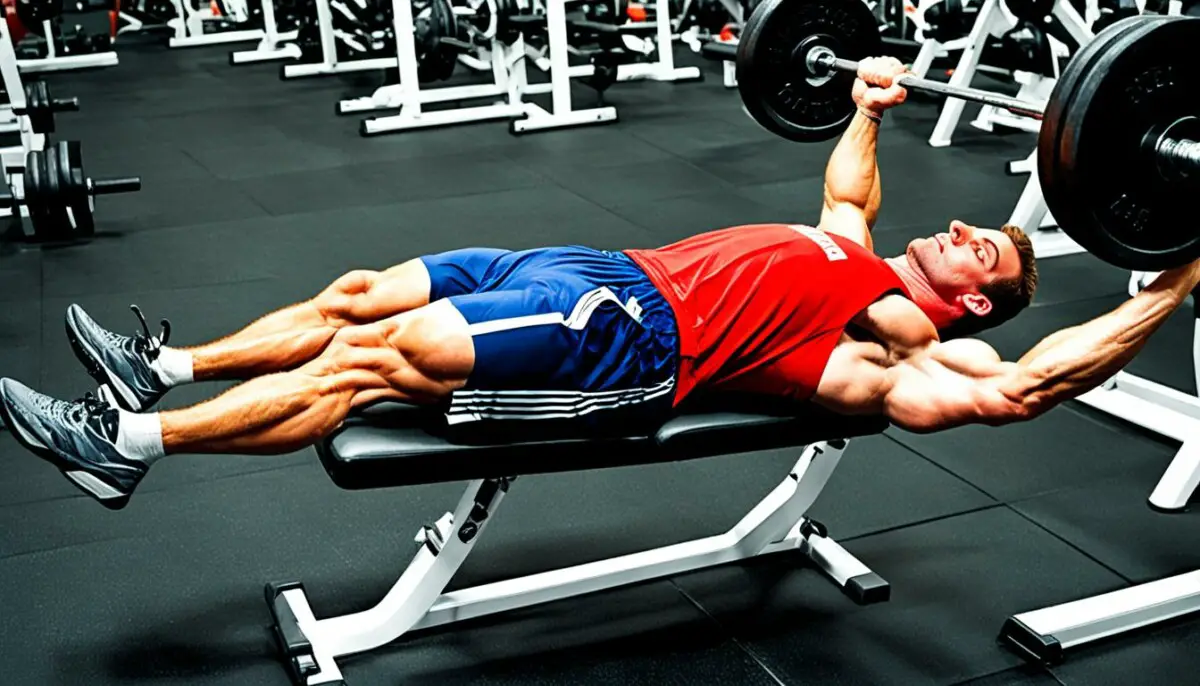Last Updated on 3 months by Francis
The incline bench press is a compound exercise that targets the upper chest muscles, shoulders, and triceps. It’s a popular variation of the classic flat bench press and is known for its ability to isolate the upper pectoral muscles more effectively. Incorporating the incline bench press into your workout routine can lead to improved upper chest development, balanced shoulder strength, and enhanced functional strength.
To get the most out of your incline bench press, mastering proper form is crucial. From setting up the bench angle to executing the exercise with controlled movements, every detail matters. By following the correct technique and avoiding common mistakes, you can maximize your gains and prevent injuries.
- Choose the proper bench angle, hand placement, and foot positioning
- Use breathing techniques and controlled descent of the bar
- Avoid flaring elbows, arching the lower back, and bouncing the bar off the chest
- Explore variations of the incline bench press for additional benefits
- Include complementary exercises in your workout routine
Contents
Key Takeaways:
- Proper incline bench form is essential for maximizing gains and preventing injuries
- Choosing the right bench angle, hand placement, and foot positioning is important
- Utilize breathing techniques and controlled movements during the exercise
- Avoid common mistakes like flaring elbows, arching the lower back, and bouncing the bar
- Explore variations of the incline bench press to target different muscle groups
Benefits of Incline Bench Press
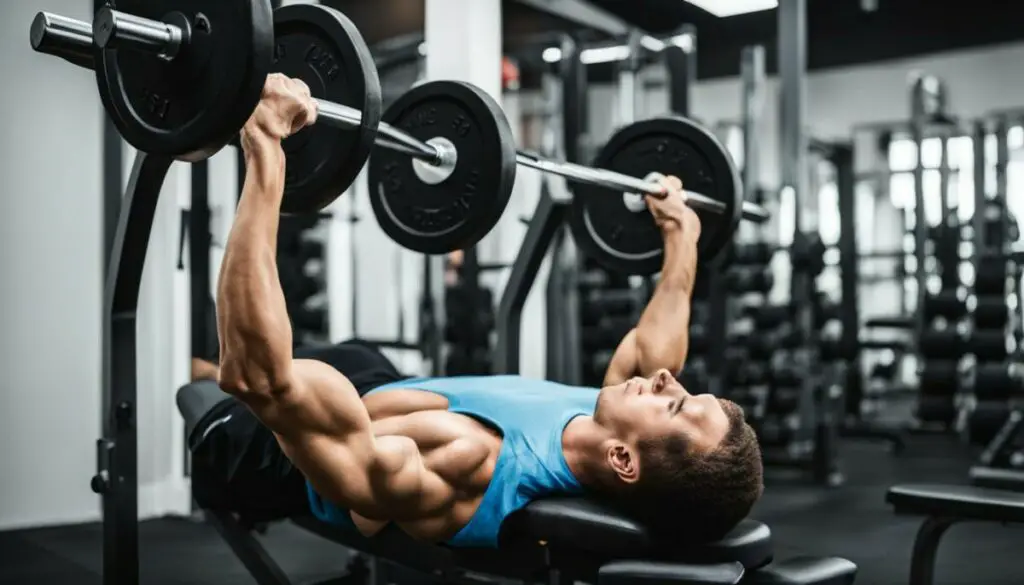
The incline bench press offers several benefits to your upper body development. It improves upper chest development by placing greater emphasis on the upper chest muscles, resulting in better overall chest aesthetics. It also contributes to balanced shoulder strength, as the incline bench press engages the front deltoids more than the flat bench press. Additionally, the movement pattern of the incline bench press simulates many real-world pushing activities, making it a practical exercise for enhancing functional strength.
“The incline bench press offers a great way to target the upper chest muscles and improve overall chest development.”
- Improves upper chest aesthetics
- Enhances shoulder strength and stability
- Builds functional strength for daily activities
- Stimulates muscle growth in the upper body
- Variety of incline angles for targeted muscle activation
By incorporating the incline bench press into your workout routine, you can enjoy these benefits and achieve a well-rounded upper body physique.
Setting Up for Incline Bench Press
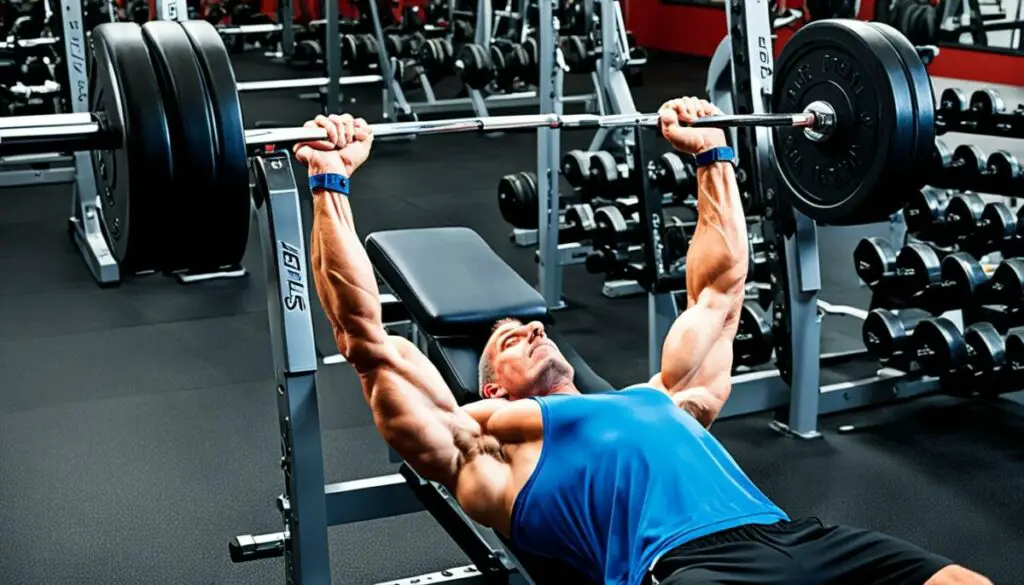
Proper setup is crucial for performing the incline bench press correctly. Here are the key elements to consider:
Bench Angle
The bench should be set at an angle between 30 and 45 degrees. Higher angles activate the shoulders more, while lower angles target the chest muscles.
Hand Placement
Position your hands slightly wider than shoulder-width apart on the barbell. This grip minimizes wrist strain and allows for optimal chest activation.
Foot Positioning
Place your feet firmly on the ground, slightly wider than shoulder-width apart. This helps maintain balance and generates power throughout the lift.
By following these setup guidelines, you’ll ensure a solid foundation for executing the incline bench press with proper form and maximizing your gains.
Executing the Incline Bench Press

Proper execution is crucial for maximizing the benefits of the incline bench press. Follow these steps to ensure you are performing the exercise correctly and effectively:
Breathing Techniques
Before starting the lift, take a deep breath and hold it. This helps stabilize your core and provides a solid base of support throughout the movement. Exhale as you push the bar away from your chest, and inhale as you prepare for the next rep.
Lowering the Bar
With a controlled motion, lower the barbell to your upper chest, just below your collarbone. Maintain a slight tuck in your elbows at a 45-degree angle to engage your chest muscles and promote proper form. Avoid flaring your elbows outward, as this can strain your shoulders and detract from chest activation.
Pressing the Bar
Push the barbell upward in a straight line by fully extending your arms without locking your elbows. Focus on contracting your chest and triceps muscles throughout the movement to maximize muscle activation. Ensure your shoulder blades remain retracted and your chest stays engaged for optimal results.
Preparing for the Next Rep
After completing a rep, maintain control of the bar and reset your form before beginning the next repetition. This includes maintaining proper breathing techniques, positioning your elbows and shoulder blades, and preparing your mind and body for continued effort.
Remember to always start with a manageable weight and gradually increase it as you gain strength and confidence. Maintaining proper form is more important than lifting heavy weights, so focus on executing the incline bench press with precision and control.
Incorporate the incline bench press into your upper body workout routine to develop a strong and defined chest, shoulders, and triceps. Combine it with variations and complementary exercises for a well-rounded strength training program.
Common Mistakes and How to Avoid Them
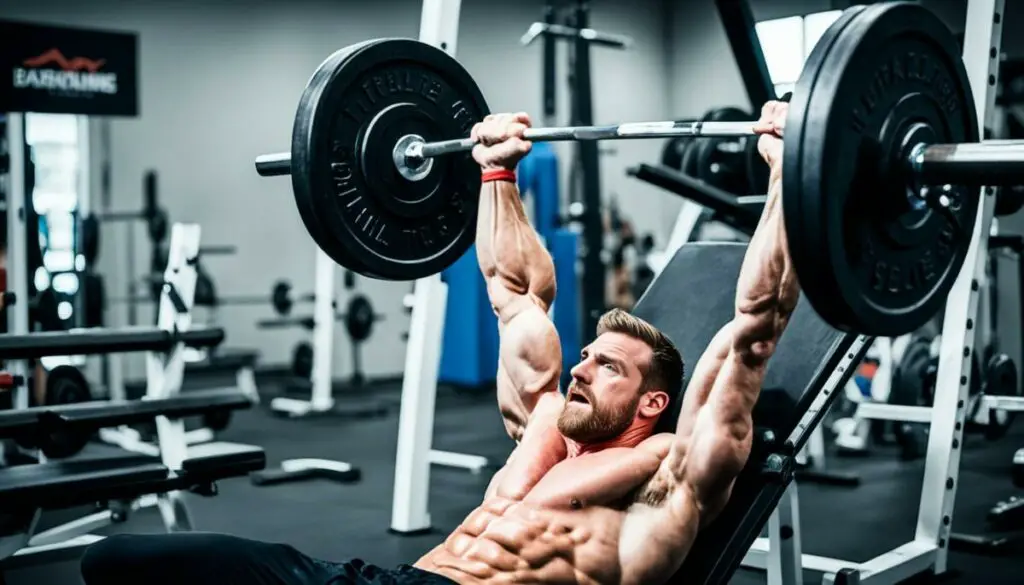
The incline bench press is a highly effective exercise for targeting the upper chest muscles, shoulders, and triceps. However, there are some common mistakes that lifters often make, which can hinder their progress and increase the risk of injury. By understanding these mistakes and learning how to avoid them, you can optimize your incline bench press technique and experience better results.
1. Flaring Elbows
One common mistake in the incline bench press is allowing the elbows to flare out to the sides. This places excessive stress on the shoulder joints and reduces the activation of the chest muscles. To avoid this, keep your elbows at a 45-degree angle from your body throughout the exercise. This helps protect your shoulders and maximizes chest engagement.
2. Arching the Lower Back
Another mistake is arching the lower back excessively during the exercise. While it’s important to maintain a natural arch in your lower back for stability, exaggerating it can lead to back strain and compromise your form. Focus on keeping your lower back pressed firmly against the bench, ensuring proper alignment and stability throughout the movement.
3. Bouncing the Bar off the Chest
One of the most common mistakes in the incline bench press is bouncing the bar off the chest. This not only reduces the effectiveness of the exercise but also increases the risk of injury. Instead, aim to control the descent of the bar, maintaining tension in your chest muscles as you gently touch the bar to your chest. This ensures that the muscles are working throughout the entire range of motion and reduces unnecessary strain on the joints.
By avoiding these common mistakes, you can maximize the benefits of the incline bench press and minimize the risk of injury. Remember to focus on maintaining proper form, engaging the target muscles, and progressing gradually with weights.
Expert Tip
“To ensure proper form in the incline bench press, start with lighter weights and focus on mastering the technique before adding more resistance. Gradually increase the weight as your strength and confidence improve, always prioritizing form and control.”
Incline Bench Press Variations
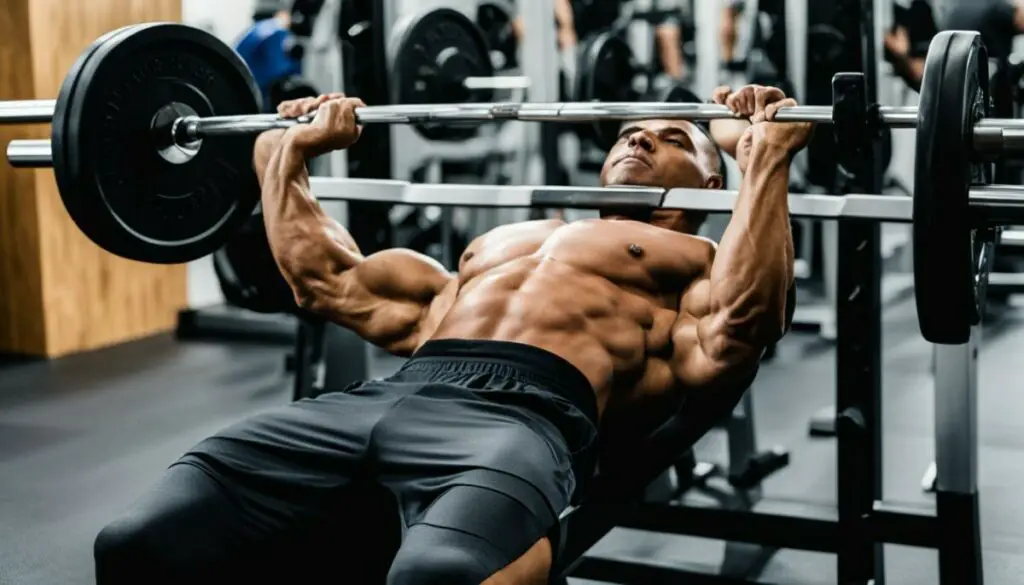
Looking to add some variety to your workouts? Incorporating different variations of the incline bench press can help target your muscles in new ways and keep your training sessions exciting. Here are three effective incline bench press variations to consider:
Incline Dumbbell Press
The incline dumbbell press is a popular variation that allows for a greater range of motion compared to the barbell variation. By using dumbbells, you can address strength imbalances between your left and right sides. This variation also requires additional stabilizing muscles, contributing to improved overall upper body strength and coordination.
Reverse Grip Incline Bench Press
If you want to place even more emphasis on your upper chest muscles, try the reverse grip incline bench press. This variation involves using an underhand grip on the barbell, which targets the upper chest and anterior deltoids to a greater extent. It can help you develop a more defined upper chest and enhance your overall upper body aesthetics.
Smith Machine Incline Bench Press
The Smith machine incline bench press is a machine-guided variation that provides stability and control. This can be particularly helpful for beginners or individuals recovering from injury. The Smith machine allows you to focus on proper form and technique without the need for a spotter. It’s a great option for building strength and gaining confidence before progressing to more advanced variations.
| Variation | Description |
|---|---|
| Incline Dumbbell Press | A variation using dumbbells, allowing for a greater range of motion and addressing strength imbalances. |
| Reverse Grip Incline Bench Press | A variation performed with an underhand grip, emphasizing the upper chest muscles. |
| Smith Machine Incline Bench Press | A machine-guided variation that provides stability and is suitable for beginners or those recovering from injury. |
By incorporating these variations into your workout routine, you can challenge your muscles in new ways and prevent plateauing. Remember to start with lighter weights to ensure proper form and gradually increase the intensity as you become more comfortable with each variation.
Complementary Exercises
To further develop your upper body strength and balance, it’s important to incorporate complementary exercises into your routine. These exercises target different muscle groups and provide a well-rounded workout. Here are three complementary exercises that can enhance your incline bench press:
1. Flat Bench Press
The flat bench press is a classic exercise that primarily targets the middle and lower chest muscles. It can be performed alongside the incline bench press to provide a comprehensive chest workout. By incorporating both exercises, you can ensure that you’re targeting all areas of your chest for balanced development.
2. Overhead Press
The overhead press is a compound exercise that strengthens the shoulders and upper back. It involves pushing a weight overhead in a vertical pressing movement. By including the overhead press in your routine, you can improve your shoulder strength, which is important for stability and overall upper body strength.
3. Push-ups
Push-ups are a versatile bodyweight exercise that can be done anywhere. They target multiple muscle groups, including the chest, shoulders, and triceps. Incorporating push-ups into your routine can help increase the overall strength and endurance of your upper body muscles. They can also be a great way to add variety to your workout.
Comparison of Complementary Exercises
| Exercise | Primary Muscles Targeted |
|---|---|
| Flat Bench Press | Middle and lower chest muscles |
| Overhead Press | Shoulders and upper back |
| Push-ups | Chest, shoulders, and triceps |
By incorporating these complementary exercises into your workout routine, you can enhance your upper body strength and balance. Remember to choose weights or modifications that challenge you while maintaining proper form. Aim for 3-4 sets of 8-12 reps for each exercise, and track your progress to set realistic goals. Keep pushing yourself and enjoy the benefits of a well-rounded upper body workout!
Structuring Your Workout Routine
When incorporating the incline bench press into your workout routine, it’s important to structure your training in a way that maximizes results and promotes muscle growth. Here are some key considerations to keep in mind:
Frequency
Aim to include the incline bench press as part of your upper body or chest-focused workout routine. Perform the exercise 2-3 times per week, allowing for 48-72 hours of rest between sessions. This allows your muscles to recover and adapt, ensuring optimal progress and preventing overtraining.
Volume and Intensity
For hypertrophy (muscle growth), aim for 3-4 sets of 8-12 reps per set. Choose a weight that challenges you while maintaining proper form. As you progress, increase the weight gradually to continue stimulating muscle growth.
Warm-up
Prior to beginning your incline bench press workout, it’s essential to warm up your muscles and prepare them for the upcoming workout. Perform dynamic stretches such as arm circles, shoulder rolls, and chest stretches to improve mobility and increase blood flow. Additionally, start with lighter sets of the incline bench press to activate the target muscles and get them ready for the main workout.
Spotter
Using a spotter during your incline bench press workouts can be beneficial, especially when lifting heavier weights. A spotter can provide assistance when needed, ensure safety, and help you push for those extra reps. Having a spotter also gives you peace of mind, allowing you to focus on your form and execution.
By structuring your incline bench press workout routine with these considerations in mind, you can optimize your training, achieve progress, and work towards your fitness goals.
Including the incline bench press in your routine can bring numerous benefits to your upper body development. However, it’s important to approach it with proper form, intensity, and recovery to ensure optimal results. By following these guidelines, you’ll be on your way to maximizing your gains and achieving a stronger, more muscular upper body.
Conclusion
The incline bench press is a highly effective exercise for targeting the upper chest muscles, shoulders, and triceps. By incorporating proper form and technique, along with variations and complementary exercises, you can optimize your fitness routine and achieve impressive results. Consistency is crucial, so make sure to stay dedicated to your workouts and strive for continuous improvement.
Proper form is essential when performing the incline bench press. Pay attention to your bench angle, hand placement, and foot positioning to ensure optimal muscle engagement and injury prevention. Remember to avoid common mistakes such as flaring elbows, arching the lower back, and bouncing the bar off the chest.
Challenge yourself by gradually increasing the weight as your strength and proficiency improve. This will help you maximize your gains and push past plateaus. As with any exercise, it is important to listen to your body, warm up properly, and give yourself adequate rest and recovery time.
FAQ
What muscles does the incline bench press target?
The incline bench press targets the upper chest muscles, shoulders, and triceps.
What are the benefits of the incline bench press?
The incline bench press improves upper chest development, balanced shoulder strength, and functional strength.
How do I set up for the incline bench press?
Choose the proper bench angle, place your hands slightly wider than shoulder-width, and position your feet firmly on the ground.
What is the proper form for executing the incline bench press?
Breathe properly, control the descent of the bar to the upper chest, and push the bar in a straight line.
What are some common mistakes to avoid in the incline bench press?
Avoid flaring elbows, arching the lower back, and bouncing the bar off the chest.
Are there variations of the incline bench press?
Yes, variations include the incline dumbbell press, reverse grip incline bench press, and Smith machine incline bench press.
What are some complementary exercises for the incline bench press?
Complementary exercises include the flat bench press, overhead press, and push-ups.
How should I structure my workout routine with the incline bench press?
Aim for 3-4 sets of 8-12 reps with a weight that challenges you while maintaining proper form. Allow 48-72 hours of rest between workouts.
What is the importance of the incline bench press?
The incline bench press is a powerful exercise that enhances upper body strength and chest development when performed with proper form and technique.

